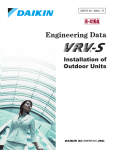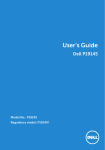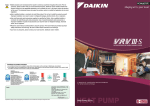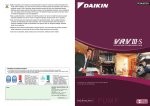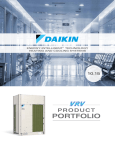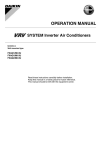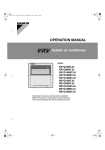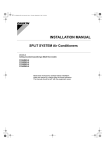Download Daikin RXYMQ36MVJU Installation manual
Transcript
00_CV_3PN00286-12Z.fm Page 1 Thursday, September 15, 2005 8:55 AM OPERATION MANUAL System air conditioner MODELS RXYMQ36MVJU RXYMQ48MVJU Read these instructions carefully before installation. Keep this manual in a handy place for future reference. This manual should be left with the equipment owner. 01_EN_3PN00286-12Z.fm Page 1 Wednesday, September 14, 2005 8:56 PM Contents Safety considerations.............................................1 Names of parts.......................................................4 Preparation Before Operation ................................6 Useful Information..................................................6 COOLING · HEATING · FAN Operation .................7 Program DRY Operation ........................................9 Adjusting the Air Flow Direction ...........................10 ON/OFF TIMER Operation .................................. 11 How to set Master Remote Controller..................12 Trouble Shooting..................................................14 Check the following before requesting service ........16 After-Sales Service ..............................................17 Safety considerations Please read these “Safety considerations” carefully before installing air conditioning equipment and be sure to install it correctly. After completing the installation, make sure that the unit operates properly during the start-up operation. Please instruct the customer on how to operate the unit and keep it maintained. Also, inform customers that they should store this operation manual along with the installation manual for future reference. This air conditioner comes under the term “appliances not accessible to the general public”. Meaning of danger, warning, caution and note symbols. DANGER ....... Indicates an imminently hazardous situation which, if not avoided, will result in death or serious injury. WARNING ..... Indicates a potentially hazardous situation which, if not avoided, could result in death or serious injury. NOTE..............Indicates situation that may result in equipment or propertydamage-only accidents. Keep these warning sheets handy so that you can refer to them if needed. Also, if this equipment is transferred to a new user, make sure to hand over this operation manual to the new user. DANGER • Refrigerant gas may produce a toxic gas if it comes in contact with fire such as from a fan, heater, stove or cooking device. Exposure to this gas could cause severe injury or death. • For refrigerant leakage, consult your dealer. Refrigerant gas is heavier than air and replaces oxygen. A massive leak could lead to oxygen depletion, especially in basements, and an asphyxiation hazard could occur leading to serious injury or death. • Any abnormalities in the operation of the air conditioner such as smoke or fire could result in severe injury or death. Turn off the power and contact your dealer immediately for instructions. • Do not install the unit in an area where flammable materials are present due to risk of explosion resulting in serious injury or death. • If equipment utilizing a burner is used in the same room as the air conditioner, there is the danger of oxygen deficiency which could lead to an asphyxiation hazard resulting in serious injury or death. Be sure to ventilate the room sufficiently to avoid this hazard. • Safely dispose of the packing materials. Packing materials, such as nails and other metal or wooden parts, may cause stabs or other injuries. Tear apart and throw away plastic packaging bags so that children will not play with them. Children playing with plastic bags face the danger of death by suffocation. CAUTION ...... Indicates a potentially hazardous situation which, if not avoided, may result in minor or moderate injury. It may also be sued to alert against unsafe practices. 1 01_EN_3PN00286-12Z.fm Page 2 Wednesday, September 14, 2005 8:56 PM WARNING • It is not good for your health to expose your body to the air flow for a long time. • The heat exchanger fins are sharp enough to cut. To avoid injury, wear gloves or cover the fins while working around them. • Ask your dealer for installation of the air conditioner. Incomplete installation performed by yourself may result in a water leakage, electric shock, and fire. • Do not put a finger or other objects into the air inlet or air outlet. The fan is rotating at high speed and will cause injury. • Ask your dealer for improvement, repair, and maintenance. Incomplete improvement, repair, and maintenance may result in a water leakage, electric shock, and fire. • Operating the air conditioner with wet hands could result in a shock hazard. • Improper installation or attachment of equipment or accessories could result in electric shock, short-circuit, leaks, fire or other damage to the equipment. Be sure only to use accessories made by Daikin which are specifically designed for use with the equipment and have them installed by a professional. • Ask your dealer to move and reinstall the air conditioner. Incomplete installation may result in a water leakage, electric shock, and fire. • Never let the indoor unit or the remote controller get wet. It may cause an electric shock or a fire. • Never use flammable spray such as hair spray, lacquer or paint near the unit. It may cause a fire. • Never replace a fuse with that of wrong ampere ratings or other wires when a fuse blows out. Use of wire or copper wire may cause the unit to break down or cause a fire. • Never remove the fan guard of the unit. A fan rotating at high speed without the fan guard is very dangerous. • Never inspect or service the unit by yourself. Ask a qualified service person to perform this work. • Cut off all electric waves before maintenance. • To avoid the risk of serious electric shock, never sprinkle or spill water or liquids on the unit. • Operating the air conditioner with wet hands could result in a shock hazard. • Do not allow children to play on or around the unit as they could be injured. 2 • Do not allow children to play on or around the unit as they could be injured. • Check the unit stand for damage on a continuous basis, especially if it has been in use for a long time. If left in a damaged condition the unit may fall and cause injury. • Placing a flower vase or other containers with water or other liquids on the unit could result in a shock hazard or fire if a spill occurs. • Do not touch the air outlet or horizontal blades while the swing flap is in operation because fingers could get caught and injured. • Be sure to establish an earth. Do not earth the unit to a utility pipe, arrester, or telephone earth. Incomplete earth may cause electrical shock, or fire. A high surge current from lightning or other sources may cause damage to the air conditioner. • Be sure to install an earth leakage breaker. Failure to install an earth leakage breaker may result in electric shocks, or fire. • Never touch the internal parts of the controller. Do not remove the front panel because some parts inside are dangerous to touch. In addition, some parts may be damaged to touching. For checking and adjusting internal parts, contact your dealer. CAUTION • Do not use the air conditioner for other purposes. In order to avoid any quality deterioration, do not use the unit for cooling precision instruments, food, plants, animals or works of art. • Do not place items under the indoor unit which may be damaged by water. Condensation may form if the humidity is above 80% or if the drain outlet gets blocked. 01_EN_3PN00286-12Z.fm Page 3 Wednesday, September 14, 2005 8:56 PM • Before cleaning, be sure to stop the operation, turn the breaker off or pull out the supply cord. Otherwise, an electric shock and injury may result. • Never expose little children, plants or animals directly to the air flow. Adverse influence to little children, animals and plants may result. • Do not wash the air conditioner with excessive water. An electric shock or fire may result. • Avoid placing the controller in a spot splashed with water. Water coming inside the machine may cause an electric leak or may damage the internal electronic parts. • Do not operate the air conditioner when using a room fumigation - type insecticide. Failure to observe could cause the chemicals to become deposited in the unit, which could endanger the health of those who are hypersensitive to chemicals. • Do not turn off the power immediately after stopping operation. Always wait at least five minutes before turning off the power. Otherwise, water leakage and trouble may occur. • The appliance is not intended for use by young children or infirm persons without supervision. • The remote controller should be installed in such away that children cannot play with it. NOTE • Never press the button of the remote controller with a hard, pointed object. The remote controller may be damaged. • Never pull or twist the electric wire of the remote controller. It may cause the unit to malfunction. • Do not place appliances which produce open fire in places exposed to the air flow from the unit or under the indoor unit. It may cause incomplete combustion or deformation of the unit due to the heat. • Arrange the drain hose to ensure smooth drainage. Incomplete drainage may cause wetting of the building, furniture etc. • Do not place the controller exposed to direct sunlight. The LCD display may get discolored, failing to display the data. • Do not wipe the controller operation panel with benzine, thinner, chemical dustcloth, etc. The panel may get discolored or the coating peeled off. If it is heavily dirty, soak a cloth in water-diluted neutral detergent, squeeze it well and wipe the panel clean. And wipe it with another dry cloth. • Dismantling of the unit, treatment of the refrigerant, oil and eventual other parts, should be done in accordance with the relevant local and national regulations. • Consult with installation contractor for cleaning the inside of the air conditioner. Wrong cleaning may make the plastics parts broken or cause failure of water leakage or electric shock. • Do not touch the air inlet or aluminium fin of the air conditioner. Otherwise, injury may be caused. • Do not place objects in direct proximity of the outdoor unit and do not let leaves and other debris accumulate around the unit. Leaves are a hotbed for small animals which can enter the unit. Once in the unit, such animals can cause malfunctions, smoke or fire when making contact with electrical parts. 3 01_EN_3PN00286-12Z.fm Page 4 Wednesday, September 14, 2005 8:56 PM Names of parts Installation site This operation manual is for the following systems with standard control. If your installation has a customized control system, ask your dealer for the operation. BFFORE INITIATION, CONTACT YOUR DEALER TO CONFIRM YOUR SYSTEM TYPE. The system provides 4 operation modes, Cool/heat changeover remote controller Operation modes Inverter series (COOLING), ❏ yes ❏ no heat pumps RXYMQ series (DRY) and (HEATING), (FAN). ATTENTION • To protect the unit, turn on the main power switch 6 hours before operation. ■ System Cool/heat changeover remote controller ■ Remote Controller (Cool/heat changeover remote controller) ■Remote Controller 6 12 4 2 9 3 OPTION 7 hr F 8 hr NOT AVAILABLE TEST 1 L H 10 11 5 22 13 20 23 24 19 TEST 15 18 14 16 17 BRC1C71 4 21 KRC19-26A 01_EN_3PN00286-12Z.fm Page 5 Wednesday, September 14, 2005 8:56 PM ON/OFF button 1 2 INSPECTION/TEST OPERATION button Press the button and the system will start. Press the button again and the system will stop. OPERATION LAMP (RED) The lamp lights up during operation. 3 DISPLAY “ UNDER CONTROL) 16 ” (CHANGEOVER DISPLAY “ This button is used only by qualified service for maintenance purposes. Do not use it in normal operation. PROGRAMMING TIME button Use this button for programming “START and/or STOP” time. TEMPERATURE SETTING button It is impossible to changeover heat/cool with the remote controller when this icon is displayed. 4 15 17 Use this button for SETTING TEMPERATURE of the thermostat. ” (AIR FLOW FLAP) 18 Refer to page 10. FILTER SIGN RESET button Refer to the operation manual attached to the indoor unit. 5 DISPLAY “ F ” (SET TEMPERATURE) FAN SPEED CONTROL button This display shows the set temperature. 6 DISPLAY “ ”“ ”“ (OPERATION MODE) ”“ 19 ” This display shows the current OPERATION MODE. DISPLAY “ 7 8 DISPLAY “ OPERATION) OPERATION MODE SELECTOR button 20 Press this button to select OPERATION MODE. ” (PROGRAMMED TIME) This display shows PROGRAMMED TIME of the system start or stop. TEST AIR FLOW DIRECTION ADJUST button 21 Refer to page 10. ” (INSPECTION/TEST NON-FUNCTIONING DISPLAY When the INSPECTION/TEST OPERATION BUTTON is pressed, the display shows the system mode is in. DISPLAY “ CONTROL) 9 10 Press this button to select the fan speed, LOW or HIGH, of your choice. ” (UNDER CENTRALIZED 22 When this display shows, the system in UNDER CENTRALIZED CONTROL. (This is not a standard specification) DISPLAY “ L H ” (FAN SPEED). 23 If that particular function is not available, pressing the button may display the words “NOT AVAILABLE” for a few seconds. When running multiple units simultaneously, the “NOT AVAILABLE” message will only be appear if none of the indoor units is equipped with the function. If even one unit is equipped with the function, the display will not appear. FAN ONLY/AIR CONDITIONING SELECTOR SWITCH Set the switch to “ ” for fan only operation or to “ heating or cooling operation. ” for The display shows the fan speed: “LOW” or “HIGH”. 11 DISPLAY “ ” (TIME TO CLEAN AIR FILTER) Refer to the operation manual attached to the indoor unit. 12 DISPLAY “ ” (DEFROST/HOT START) Refer to page 8. 13 TIMER MODE START/STOP button Refer to page 11. 14 COOL/HEAT CHANGEOVER SWITCH 24 Set the switch to “ operation. ” for cooling or to “ ” for heating NOTE • For the sake of explanation, all indications are shown on the display in the left figure contrary to actual operating situations. • If the display “Time to clean air filter” lights up, clean the air filter as explained in the indoor unit operation manual. After cleaning and reinstalling the air filter, press the filter sign reset button on the remote controller. The display will go out. TIMER ON/OFF button Refer to page 11. 5 01_EN_3PN00286-12Z.fm Page 6 Wednesday, September 14, 2005 8:56 PM Preparation Before Operation ■ Tips for saving energy • Be careful not to cool (heat) the room too much. Recommended temperature setting Keeping the temperature setting at a moderate level helps save energy. For cooling 79 to 83 °F • Cover windows with a blind or a curtain. Blocking sunlight and air from outdoors increases the cooling (heating) effect. For heating 68 to 75 °F ■ Operation range If the temperature or the humidity is beyond the following conditions, safety devices may work and the air conditioner may not operate, or sometimes, water may drop from the indoor unit. Cooling Heating INDOOR TEMPERATURE DB WB 70 to 90 °F 57 to 77 °F HUMIDITY 80% or below (Long time operation in a humidity over 80% may cause condensation on the unit and dripping.) OUTDOOR TEMPERATURE INDOOR TEMPERATURE DB DB 59 to 81 °F 23 to 115 °F OUTDOOR TEMPERATURE DB –4 to 70 °F** WB –4 to 60 °F** **–4~5°FWB: Range for operation 5~60°FWB: Range for continuous operation DB: Dry bulb temperature WB: Wet bulb temperature The setting temperature range of the remote controller is 60°F to 90°F. Useful Information Observe the following precautions to ensure the system operates properly. • Set the room temperature appropriately. Take care not to cool or heat the room excessively. Adjust the temperature so that everyone in the room is comfortable. 79-83°F during cooling 68-75°F during heating • Ventilate the room from time to time. Be sure to ventilate the room after using the air conditioner for a long time. • Do not leave the door or window open. The air will be released, and the effect of cooling/heating will be reduced. • Do not allow direct sunshine to enter the room during the cooling operation. Hang a curtain or blind to the window to prevent direct sunshine. • Keep televisions, radios or stereo equipment at least 3.5ft. from the indoor unit or remote controller. Otherwise, picture disturbance or noise may result. 6 • Turn off the power when the air conditioner is not used for a long time. With the power on, the air conditioner will consume several to several tends of watts of power (∗1) OFF NOTE ∗1 The power consumption while the equipment is stopped varies with the type of outdoor unit, etc. Consult your dealer for further details on power consumption. • Do not use and room heater under the indoor unit. Heat may deform the suction grille of indoor unit. • Do not place things near the air outlet or air inlet. Such obstacles may lower the performance of the air conditioner or make it stop. • When the display shows “ ” (TIME TO CLEAN AIR FILTER), refer to the instruction manual of the indoor unit, and clean the air filter. 01_EN_3PN00286-12Z.fm Page 7 Wednesday, September 14, 2005 8:56 PM COOLING · HEATING · FAN Operation This operation manual describes the explanation for a case in which the wired remote controller is used. When using the wireless remote controller, refer to the attached operation manual. ” (CHANGEOVER UNDER CONTROL). • Changeover cannot be made with a remote controller whose display shows “ • When the display “ ” (CHANGEOVER UNDER CONTROL) flashes, refer to page 13. • For protecting the unit, supply the power for 6 hours at first, then operate the air conditioner. FOR SYSTEMS WITHOUT COOL/HEAT CHANGEOVER REMOTE CONTROLLER 2·6 F TEST H 3 1 4 5 1. Press OPERATION MODE SELECTOR button several times and select the OPERATION MODE of your choice as follows. 2. COOLING Operation ...... “ ” HEATING Operation .... “ ” Press ON/OFF button. OPERATION lamp lights up and the system starts OPERATION. FAN Operation ...... “ ” FOR SYSTEMS WITH COOL/HEAT CHANGEOVER REMOTE CONTROLLER Cooling Operation 1 Heating Operation 1 Fan Operation 1 2·6 F 5 1 1 4 3 1. Select operation mode with the cool/heat changeover remote controller as follows: 2. COOLING Operation ...... “ ”“ ” HEATING Operation .... “ Press ON/OFF button. OPERATION lamp lights up and the system starts OPERATION. ”“ ” FAN Operation...... “ ” Adjustment 3. Press TEMPERATURE SETTING button and program the setting temperature. Each time this button is pressed, setting temperature rises 1°F. Each time this button is pressed, setting temperature lowers 1°F. NOTE: • Set the temperature within the operation range shown in the table on page 6. • The temperature cannot be set in the fan operation. 7 01_EN_3PN00286-12Z.fm Page 8 Wednesday, September 14, 2005 8:56 PM COOLING · HEATING · FAN Operation 4. Press FAN SPEED CONTROL button. High or Low fan speed can be selected. NOTE: • In the heating operation, the fan stops during defrosting or at startup. It does not indicate any abnormality. 5. Press AIR FLOW DIRECTION ADJUST button. (only for FXFQ, FXHQ, FXAQ) Refer to page 10 for details. STOPPING THE SYSTEM 6. Press ON/OFF button once again. • OPERATION lamp goes off, and the system stops OPERATION. • The fan may keep on running for about 1 minute after the heating operation stops. (To start the next operation smoothly.) ATTENTION: • Do not turn OFF power immediately after the unit stops. Then, wait no less than 5 minutes. Water is leaking or there is something else wrong with the unit. • When the operation is started again immediately after being stopped, when the operation mode is changed over, or when the TEMPERATURE SETTING button is pressed then returned soon, the air conditioner will start the operation automatically about 5 minutes later (because the air conditioner is controlled so that excessive load is not applied). Characteristics of the heating operation (1) DEFROST OPERATION • As the frost on the coil of outdoor unit increases, heating effect decreases and the system goes into DEFROST OPERATION. • The indoor unit fan stops and the remote controller displays shows “ ” (DEFROST/HOT START). • After 6 to 8 minutes (maximum 10 minutes) of DEFROST OPERATION, the system returns to HEATING OPERATION. (2) HOT START • In order to prevent cold air from blowing out of an indoor unit at the start of heating operation, the indoor fan is automatically stopped. The display of the remote controller shows “ ” (DEFROST/HOT START). (3) OPERATION START • For ordinary heating, it will take longer for the room temperature to reach the set temperature than with cooling. We therefore recommend starting the unit ahead of time using the timer operation. 8 01_EN_3PN00286-12Z.fm Page 9 Wednesday, September 14, 2005 8:56 PM Program DRY Operation Program DRY is a function that alternates between weak cooling and stopping the unit to remove humidity from the air, in order to prevent the room temperature from dropping and becoming too cold. • The microcomputer automatically controls the temperature and fan strength, so these cannot be set using the remote controller. • This function is not available if the room temperature is 60°F or lower. FOR SYSTEMS WITHOUT COOL/HEAT CHANGEOVER REMOTE CONTROLLER 2·5 TEST 1 4 1. Press OPERATION MODE SELECTOR button several times and select “ ” (PROGRAM DRY Operation). 2. Press ON/OFF button. OPERATION lamp lights up and system starts OPERATION. FOR SYSTEMS WITH COOL/HEAT CHANGEOVER REMOTE CONTROLLER 3-5 1 4 1 2 1. Select cooling operation mode with the cool/heat changeover remote controller. 2. Press OPERATION MODE SELECTOR button several times and select “ ” (PROGRAM DRY Operation). 3. Press ON/OFF button. OPERATION lamp lights up and system starts OPERATION. Adjustment 4. Press AIR FLOW DIRECTION ADJUST button. (only for FXFQ, FXHQ, FXAQ) Refer to page 10 for details. STOPPING THE SYSTEM 5. Press ON/OFF button again. OPERATION lamp goes off, and the system stops OPERATION. ATTENTION: • Do not turn OFF power immediately after the unit stops. Then, wait on less than 5 minutes. Water is leaking or there is something else wrong with the unit. 9 01_EN_3PN00286-12Z.fm Page 10 Wednesday, September 14, 2005 8:56 PM Adjusting the Air Flow Direction • Press the AIR FLOW DIRECTION button to adjust the air flow angle. (only F TEST for FXFQ, FXHQ, FXAQ) H 1 1. Press the AIR FLOW DIRECTION ADJUST button to select the air direction as shown below. swing The AIR FLOW FLAP display swings as shown left and the air flow direction continuously varies. (Automatic swing setting) Press AIR FLOW DIRECTION ADJUST button to select the air direction of your choice. The AIR FLOW FLAP display stops swinging and the air flow direction is fixed. (Fixed air flow direction setting) MOVEMENT OF THE AIR FLOW FLAP For the following conditions, micro computer controls the air flow direction so it may be different from the display. Operation mode Operation conditions Cooling Heating • When room temperature is lower than • When room temperature is higher than the set temperature the set temperature • At defrost operation • When operating continuously at horizontal air flow direction The air flow direction can be adjusted in either of the following ways. • Automatic The air flow flap adjusts its position itself. • Fixed air flow direction The air flow direction can be fixed by the user. <Automatic> FXFQ FXHQ <Fixed air flow direction> FXFQ FXHQ FXAQ FXAQ ATTENTION: • The movable limit of the flap is changeable. Contact your dealer for details. (Only for FXFQ, FXHQ and FXAQ.) • Avoid operating in the horizontal direction “ ” which may cause dew or dust to settle on ceiling. 10 01_EN_3PN00286-12Z.fm Page 11 Wednesday, September 14, 2005 8:56 PM ON/OFF TIMER Operation • The timer is operated by the following two ways. Programming the stop time ( ) ........ The system stops operating after the time setting has elapsed. Programming the start time ( ) ......... The system starts operating after the time setting has elapsed. • The timer can be programmed for a maximum of 72 hours. • The start and the stop time can simultaneously be programmed. hr F 1 3 TEST H 2 1. Press the TIMER MODE START/STOP button several times and select the mode on the display. The display flashes. For setting the timer stop...“ For setting the timer start...“ ” ” 2. Press the PROGRAMMING TIME button and set the time for stopping or starting the system. When this button is pressed, the time advances by 1 hour. When this button is pressed, the time goes backward by 1 hour. 3. Press the TIMER ON/OFF button. The timer setting procedure ends. The display “ or ” changes from flashing light to a constant light. NOTE: • When setting the timer Off and On at the same time, repeat the above procedure (from 1 to 3) once again. • After the timer is programmed, the display shows the remaining time. • Press the TIMER ON/OFF button once again to cancel programming. The display vanishes. For example: When the timer is programmed to stop the system after 3 hours and start the system after 4 hours, the system will stop after 3 hours and then 1 hour later the system will start. 11 01_EN_3PN00286-12Z.fm Page 12 Wednesday, September 14, 2005 8:56 PM How to set Master Remote Controller • When the right to select the cooling/heating operation mode is set in the master remote controller, “ ” is dis- played in slave remote controllers. The right to select the cooling/heating operation mode cannot be set in slave remote controllers. F H 1·2·3 TEST Setting the master remote controller • When the system is installed as shown below, it is necessary to designate the master remote controller. • Only the remote controller having the right to select the cooling/heating operation mode (master remote controller) can select the cooling/heating operation mode. When one outdoor unit is connected with several indoor units. Cool/heat changeover remote controller • The displays of slave remote controllers show “ ” (CHANGEOVER UNDER CONTROL) and they automatically follow the operation mode directed by the master remote controller. (This symbol is not displayed in wireless remote controllers.) However, it is possible to changeover to PROGRAM DRY with slave remote controller only if the system is in COOLING OPERATION set by the master remote controller. 12 01_EN_3PN00286-12Z.fm Page 13 Wednesday, September 14, 2005 8:56 PM How to designate the master remote controller 1. Continuously press the OPERATION MODE SELECTOR button of the current master remote controller for 4 seconds. 2. The displays showing “ ” (CHANGEOVER UNDER CONTROL) of all slave remote controllers connected to the same outdoor unit flash. Press the OPERATION MODE SELECTOR button of the controller that you wish to designate as the master remote controller. Then designation is completed. This remote controller is designated as the master remote controller and the display showing “ ” (CHANGEOVER UNDER CONTROL) vanishes. The displays of other remote controllers show “ ” (CHANGEOVER UNDER CONTROL). 3. Press the OPERATION MODE SELECTOR button of the master remote controller (in which “ ” is not displayed) several times, and select the operation mode that you wish. Every time the OPERATION MODE SELECTOR button is pressed, the indication is changed over in the sequence “fan” → “dry” → “cooling” → “heating”. The indication in other slave remote controllers is changed over while following up the indication in the master unit. In the case of wireless remote controllers 1. Continuously press the OPERATION MODE SELECTOR button of the current master indoor unit for 4 seconds. The timer lamp flashes in all indoor units connected to the same outdoor unit. 2. Press the OPERATION MODE SELECTOR button of the indoor unit that you wish to designate as the master indoor unit. 3. A “beep” sound is issued, and the timer lamp turns off. This indoor unit is designated as the master unit. Press the OPERATION MODE SELECTOR button of the master indoor unit several times, and select the operation mode that you wish. Every time the OPERATION MODE SELECTOR button is pressed, the indication is changed over in the sequence “fan” → “dry” → “cooling” → “heating”. The indication in other slave indoor unit is changed over while following up the indication in the master indoor unit. Contents and functions of operation 1. When master remote controller (in which “ ” is not displayed) is set to “cooling” or “heating” Other slave remote controllers (in which “ ” is displayed) • The operation mode is changed over to the mode selected in the master remote controller. Display in slave remote controllers 1.The set temperature selected in the same mode at the previous time is displayed. 2.The initial setting is displayed. (When the mode is set for the first time.) Cooling: 83°F 2. When master remote controller (in which “ ” is not displayed) is set to “fan”. Other slave remote controllers (in which “ ” is displayed) • Only “fan” is available. Heating: 72°F • However, changeover to the fan operation and changeover from “cooling” to “dry” are available. In the case of wireless remote controllers When an operation mode different from the currently selected operation mode is selected in a slave remote controller, a long “beep” sound is issued to notify that the mode is in conflict. PRECAUTIONS FOR GROUP CONTROL SYSTEM OR TWO REMOTE CONTROLLER CONTROL SYSTEM This system provides two other control systems beside individual control (one remote controller controls one indoor unit) system. Confirm the following if your unit is of the following control system type. • Group control system One remote controller controls up to 16 indoor units. All indoor units are equally set. • Two remote controller control system Two remote controllers control one indoor unit (in case of group control system, one group of indoor units). The unit is individually operated. NOTE: • Contact your dealer in case of changing the combination or setting of group control and two remote controller control systems. 13 01_EN_3PN00286-12Z.fm Page 14 Wednesday, September 14, 2005 8:56 PM Trouble Shooting These cases are not troubles. The following cases are not air conditioner troubles but have some reasons. You may just continue using it. Case Explanation The air conditioner does not operate at all. • When the breaker is OFF. • When the power is interrupted. Operation does not start soon. • When ON/OFF button was pressed soon after operation was stopped. • When the mode was reselected. Hot air does not flow out soon after the power supply is turned on. • Set to ON the breaker. • Wait until the power is recovered, then operate the air conditioner again. The air conditioner The heating operation stops suddenly and a flowing sound is heard. • A “Zeen” sound is heard immediately after the power supply is turned on. A continuous low “Shah” sound is heard when the system is in COOLING OPERATION or at a stop. A “Pishi-pishi” squeaking sound is heard when the system stops after HEATING OPERATION. A low “Sah”, “Choro-choro” sound is heard while an indoor unit has stopped. A continuous low “Shuh” sound is heard when the systems is in COOLING or DEFROST OPERATION. A “Shuh” sound which is heard at the start or immediately after the stop of operation or which is heard at the start or immediately after the stop of DEFROST OPERATION. When the tone of operating noise changes. A continuous “shuh” sound generated during operation or immediately after the operation is started or stopped. The outdoor unit emits water or steam. Mists come out of the indoor unit. The indoor unit gives out odour. 14 automatically resumes operation in about 3 minutes. You should just wait for a while. • This is to protect the air conditioner. • • • • You should wait for about 5 minutes. The micro computer is preparing for operation. Wait for about 10 minutes. The air conditioner is warming up. You should wait for about 1 minutes. (The system is designed to start discharging air only after it has reached a certain temperature.) The system is taking away the frost on the outdoor unit. You should wait for about 3 to 8 minutes. (Max. 10 minutes). This sound indicates that the valve for the refrigerant bypass is in operation. The electronic expansion∗ valve inside an indoor unit starts working and makes the noise. Its volume will reduce in about one minute. ∗ Electronic expansion valve … Controls the flow rate of the gas (refrigerant) flowing inside the indoor unit. When the drain pump (optional accessory) is in operation, this noise is heard. • Expansion and contraction of plastic parts caused by temperature change makes this noise. • When the other indoor unit is in operation, this noise is heard. In order to prevent oil and refrigerant from remaining in the system, a small amount of refrigerant is kept flowing. • This is the sound of refrigerant gas flowing through both indoor and outdoor units. • This is the noise of refrigerant caused by flow stop and flow change. • This noise caused by the change of frequency. • This sound indicates that the valve for the refrigerant bypass is in operation. ■ In HEATING mode • The frost on the outdoor unit melts into water or steam when the air conditioner is in defrost operation. ■ In COOLING or DRY mode • Moisture in the air condenses into water on the cool surface of outdoor unit piping and drips. • This happens when the air in the room is cooled into mist by the cold air flow during cooling operation. • If the inside of an indoor unit is extremely contaminated, the temperature distribution inside a room becomes uneven. It is necessary to clean the inside of the indoor unit. Ask your dealer for details on cleaning the indoor unit. This operation requires a qualified service person. ■ This happens when smells of the room, furniture, or cigarettes are absorbed into the unit and discharged with the air flow. (If this happens, we recommend you to have the indoor unit washed by a technician. Consult the service shop where you bought the air conditioner.) 01_EN_3PN00286-12Z.fm Page 15 Wednesday, September 14, 2005 8:56 PM Trouble Shooting Case The outdoor fan rotates while the air conditioner is not in operation. The operation stopped suddenly. (OPERATION lamp is on) “ ” is displayed on the remote controller, and the displayed contents flash for several seconds when an operation button is pressed. When three short “beep” sounds are issued in the case of wireless remote controller. COOL/HEAT cannot be changed over. ” • When the display shows “ (CHANGEOVER UNDER CONTROL), it shows that this is a slave remote controller. • When the cool/heat changeover remote control switch is installed and the display shows “ ” (CHANGEOVER UNDER CONTROL). When a long “beep” sound is issued in the case of wireless remote controller. The liquid crystal of the remote controller shows “ ” immediately after the power supply is turned on. The compressor in the outdoor unit does not stop after a short HEATING operation. The inside of an outdoor unit is warm when the unit has stopped Explanation ■ After operation is stopped: • The outdoor fan continues rotating for another 60 seconds for system protection. ■ While the air conditioner is not in operation: • When the outdoor temperature is very high, the outdoor fan starts rotating for system protection. ■ For system protection, the air conditioner may stop operating on a sudden large voltage fluctuation. It automatically resumes operation in about 3 minutes. • The air conditioner is controlled by the central equipment. Flashing of the displayed contents indicates that the remote controller is invalid for control. • Refer to page 13. • This is because cool/heat changeover is controlled by the cool/heat changeover remote control switch. Ask your dealer where the remote control switch is installed. • This shows that the remote controller is in normal condition. This continues for one minute. • This is to prevent oil and refrigerant from remaining in the compressor. The unit will stop after 5 to 10 minutes. • This is because the crankcase heater is warming the compressor even while the outdoor unit is stopped so that the compressor can start smoothly. • For protecting the unit, supply the power for 6 hours at first, then operate the air conditioner. When the air conditioner has not been used (the power has been off) for a long time. Warm air exits the unit even though it is • Multiple units are operating on the same system, so if a unit in another off. room is operating, some refrigerant will flow through the stopped units, You can feel hot air coming out of the unit. too. Call the service shop immediately. WARNING ■ When an abnormality (such as a burning smell) occurs, stop operation and turn the breaker OFF. Continued operation in an abnormal condition may result in troubles, electric shocks or fire. Consult the service shop where you bought the air conditioner. ■ Do not attempt to repair or modify the air conditioner by yourself. Incorrect work may result in electric shocks or fire. Consult the service shop where you bought the air conditioner. 15 01_EN_3PN00286-12Z.fm Page 16 Wednesday, September 14, 2005 8:56 PM If one of the following symptoms takes place, call the service shop immediately. ■ The power supply wire is abnormally hot or damaged. ■ An abnormal sound is heard during operation. ■ The safety breaker, a fuse, or the earth leakage circuit breaker cuts off the operation frequently. ■ A switch or a button often fails to work properly. ■ There is a burning smell. ■ Water leaks from the indoor unit. ■ After a power failure The air conditioner automatically resumes operation in about 3 minutes. You should just wait for a while. Turn the breaker OFF and call the service shop. ■ Lightning If lightning may strike the neighboring area, stop operation and turn the breaker OFF for system protection. Check the following before requesting service Symptom Action and contact If a safety device such as a fuse, a breaker or an earth leakage breaker frequently actuates. Do not turn on the main power switch. If the ON/OFF switch does not properly work. Turn off the main power switch. Water leaks from the air conditioner. Stop operation. If the display “ ” (INSPECTION), UNIT No.” and the OPERATION lamp flash and “MALFUNCTION CODE” appears. Inform your dealer of the contents of the display on the remote contoller. OPERATION lamp UNIT No. F INSPECTION display Symptom The machine does not work at all. H INDOOR UNIT No. in which a malfunction occurs MALFUNCTION CODE Cause Remedy Blown fuse or open breaker Replace the fuse or close the breaker. Power outage If the main power supply is turned off during operation, operation will restart automatically after power turns back again. The machine runs but stops soon. Blocked air inlet or air outlet of the Remove the obstacle. indoor or outdoor unit The machine does not work Blocked air inlet or air outlet of indoor properly. or outdoor unit Remove the obstacle. Improper temperature setting See page 7. Low fan speed setting See page 7. Improper air flow direction See page 10. Window or door open Close. Direct sunshine Put up a curtain or blind over the window. Too many people in the room Too many heat sources in the room If the air filter clogged. Refer to the instruction manual of the indoor unit, and clean the air filter. NOTE • Check the above items, and if the problem still cannot be fixed, contact your dealer for repair, stating the symptom(s) and the model name. 16 01_EN_3PN00286-12Z.fm Page 17 Wednesday, September 14, 2005 8:56 PM After-Sales Service CAUTION • Do not disassemble, modify or repair the air conditioner by yourself. Improper disassembly, modification or repair may cause water leakage, electric shock or fire. Ask your dealer for such servicing. • Do not move and install the air conditioner by yourself. Improper reinstallation may cause water leakage, electric shock or fire. Ask your dealer for reinstallation. • Objects which can start fire are strictly prohibited if the refrigerant leaks. The refrigerant used in the air conditioner is safe, and does not leak usually. If the refrigerant leaks into the room and becomes contact with burning appliances such as fan heater, stove and cooker, however, harmful gases may be generated. Turn off burning appliances, ventilate the room, and contact your dealer. After asking for repair of refrigerant leakage, confirm to the service personnel that the leaking positions are repaired securely, then start the operation. We recommend periodical maintenance In certain operating conditions, the inside of the air conditioner may get foul after several seasons of use, resulting in poor performance. It is recommended to have periodical maintenance by a specialist aside from regular cleaning by the user. For specialist maintenance, contact the service shop where you bought the air conditioner. The maintenance cost must be born by the user. 17 00_CV_3PN00286-12Z.fm Page 2 Thursday, September 15, 2005 8:55 AM 1645 Wallace Drive, Suite 110 Carrollton, TX 75006 [email protected] www.daikinac.com 3PN00286-12Z EM04A030A (0510) HT



















